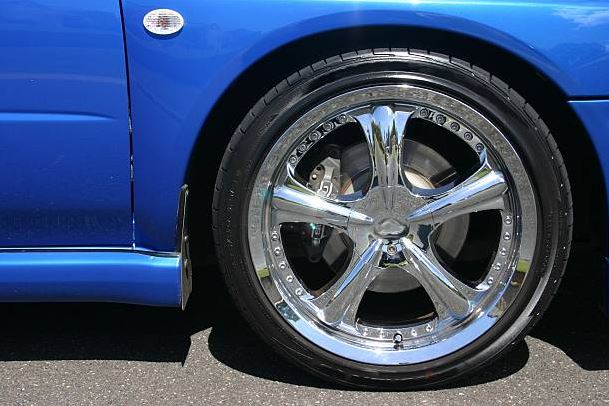With a sidewall aspect ratio of less than 50, low-profile tires are primarily designed with thinner and stiffer sidewalls to make the rims stand out while improving steering response and traction.
These fancy-looking, sporty tires are loved for their aesthetics, better steering wheel response, improved vehicle handling, and better fuel economy. But how well do they measure up when it comes to longevity?
Table of Contents
So How Long Do Low-Profile Tires Last?
You can expect a quality low-profile tire to last 45,000 to 50,000 miles (80,000 km). Most manufacturers also offer this as a limited warranty. In other words, a low-profile tire will last for around three and a half years if you cover an average mileage of 14,000 miles per year.
However, the lifespan of an average low-profile tire will depend on the driving conditions, habits, and how they are used. It also depends on the softness of the compound of the tire since it speaks volumes of the tire’s durability.
Low-profile tires are designed for better grip and aggressive driving style, hence their short sidewall. This means they are designed with softer compounds that wear out more quickly (not because of the short sidewall.)
So if a high-profile tire has the same softer compound, it would likely wear out as quickly also. For this reason, there is no significant difference between the longevity of traditional, high-profile, and low-profile tires.
What Determines the Lifespan of a Low-Profile Tire?
While low-profile tires have an expected mileage to cover before deteriorating, the length at which they serve you optimally depends on the road surface you travel on, as road hazards like potholes, debris, bumps, and curbs can reduce the lifespan of your tires.
Aside from these, it would help if you also looked out for the following, as they directly determine how long these thin sidewall tires will last:
| Factor | Effect |
| Seasonal effects | Seasonal conditions like winter are not an ideal period to drive on low-profile tires because they tend to wear out the family more quicker. |
| Road condition | Low-profile tires may be able to hold up in rain but if you constantly drive on wet surfaces, your low-profile tire’s lifespan shortens |
| Excessive speed | Low-profile tires are likely to wear out faster when you drive at excessive speeds often |
For these reasons, the National Highway Traffic Safety Administration (NHTSA) recommends replacing low-profile tires at least once every six years, no matter the miles you’ve covered. (More on this in the next section.) Observing routine inspections is also encouraged.
How Often Should You Change Low Profile Tires?
As mentioned earlier, the average lifespan of a regular low-profile tire is around 4 years or 50,000 miles. So it is expected to get replaced after such a period.
But if you observe scheduled maintenance after rotated every few thousand miles, low-profile tires can go for as long as 5 years.
Still, the NHTSA recommends low-profile tire owners get it replaced at least once every six years, even if they seem in good condition.
Will Low Profile Tires Last Longer Than High Profile Tires?
In general, low-profile tires tend to have a shorter lifespan than high-profile tires. This is because low-profile tires have softer compounds and less sidewall, so there is less rubber to absorb impacts and protect the tire’s internal structure.
As a result, low-profile tires are more susceptible to damage from potholes, curbs, and other road hazards.
On the other hand, high-profile tires have a larger sidewall, which provides more cushioning and protection against impacts. This can help them last longer, especially on rough roads or in areas with a lot of debris.
It’s important to note that the lifespan of a tire can also be influenced by several other factors, including the type of tire, the manufacturer, the tread pattern, the vehicle’s weight, load capacity, and the driver’s driving habits.
How To Make Low Profile Tires Last Longer
There are a few things you can do to help extend the lifespan of low-profile tires:
1. Properly maintain your tires
Keep your tires properly inflated, as under-inflation can cause excess heat buildup and accelerate tire wear. Rotate your tires regularly to ensure even wear, and have your wheels balanced to reduce vibrations that can cause premature tire wear.
2. Avoid overloading your tires.
Stay within the recommended load capacity for your tires. Overloading your tires can cause excess strain on the tire’s internal structure and lead to premature wear.
3. Avoid extreme driving conditions.
Low-profile tires may not be suitable for off-road driving or driving in extreme weather conditions, such as deep snow or heavy rain. Avoiding these conditions can help protect your tires from damage.
4. Use tire protectant
Applying a tire protectant can help extend the life of your low-profile tires by protecting them from the elements and preventing cracking or drying out.
5. Use good driving habits.
Avoid sudden starts, stops, and sharp turns, as these can cause excess strain on your tires. Smooth, consistent driving can help extend the life of your tires.
It’s also a good idea to regularly inspect your tires for signs of wear or damage and replace them as needed to ensure safe and reliable performance.
Finally
Low-profile tires have pros and cons, as with every other tire type and grade. The longevity of these fancy-looking tires may be a tradeoff compared to other tire types. But still, users enjoy improved looks, better handling, and more grip for extra performance.
If you frown at reduced ride quality, increased cost, and less protection for wheels and suspension, then it’s best to opt for regular or high-profile tires.
Over to you; how long have you been using your low-profile tire? Would the pros outweigh the cons? I’ll be in the comments.

